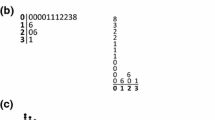Summary
Principal components analysis is well suited for many data analysis problems in ecology, particularly for data reduction and hypothesis generation; but the structure of PCA is poorly suited for indirect gradient analysis. Whatever the intended application of PCA, the user must exercise special care in selecting data transformations to prevent the analysis from being overwhelmed by the purely numerical effects in the variance structure of the data.
Similar content being viewed by others
References
Austin, M. P. 1968. An ordination study of a chalk grassland community. J. Ecol. 56: 739–758.
Cassie, R. M. 1963. Multivariate analysis in the interpretation of numerical plankton data. N.Z.J. Sci. 6: 36–59.
Cassie, R. M. 1972. Fauna and sediments of an intertidal mudflat: an alternative multivariate analysis. J. Exp. Mar. Biol. Ecol. 9: 55–64.
Cassie, R. M. & A. D. Michael. 1968. Fauna and sediments of an intertidal mud-flat: a multivariate analysis. J. Exp. Mar. Biol. Ecol. 2: 1–23.
Dale, M. B. 1975. On objectives of methods of ordination. Vegetatio 30: 15–32.
Gauch Jr., H. G. & R. H. Whittaker. 1972. Comparison of ordination techniques. Ecol. 53: 868–875.
Gauch Jr., H. G., R. H. Whittaker & T. R. Wentworth. 1977. A comparative study of reciprocal averaging and other ordination techniques. J. Ecol. (in press).
Goff, F. C. 1975. Comparison of species ordinations resulting from alternative indices of interspecific association and different numbers of included species. Vegetatio 31: 1–14.
Goodall, D. W. 1954. Objective methods in the classification of vegetation. III. An essay on the use of factor analysis. Aust. J. Bot. 2: 304–324.
Goodall, D. W. 1970. Statistical plant ecology. Ann. Rev. Ecol. Syst. 1: 99–124.
Hill, M. O. 1973. Reciprocal averaging: an eigenvector method of ordination. J. Ecol. 61: 237–249.
James, F. C. 1971. Ordinations of habitat relationships among breeding birds. Wilson Bull. 83: 215–236.
Kessell, S. R. & R. H. Whittaker. 1976. Comparisons of three ordination techniques. Vegetatio 32: 21–29.
Morrison, D. F. 1967. Multivarlate Statistical Methods. McGraw-Hill, New York. 338 pp.
Nichols, S. 1977. Phytoplankton species relationships at short time scales. (in preparation).
Noy-Meir, I., 1971. Data transformations in ecological ordination. I. Some advantages of non-centering. J. Ecol. 61: 329–341.
Noy-Meir, I., D. Walker & W. T. Williams. 1975. Data transformations in ecological ordination. II. On the meaning of data standardization. J. Ecol. 63: 779–800.
Noy-Meir, I. & R. H. Whittaker. 1977. Recent developments in continuous multivariate techniques. In: R. H. Whittaker (ed.). Ordination of Plant Communities. Junk, The Hague. (in press).
Orlóci, L. 1966. Geometric models in ecology. I. The theory and application of some ordination methods. J. Ecol. 54: 193–215.
Orlóci, L. 1974. On information flow in ordination. Vegetatio 19: 11–16.
Pielou, E. C. 1969. An Introduction to Mathematical Ecology. Wiley, New York, 286 pp.
Yarranton, G. A. 1967. Principal components analysis of data from saxicolous bryophyte vegetation at Steps Bridge, Devon. Can. J. Bot. 45: 93–115.
Author information
Authors and Affiliations
Additional information
I would like to thank R. H. Whittaker, H. G. Gauch, R. E. Moeller, and S. R. Searle for their guidance and assistance.
Rights and permissions
About this article
Cite this article
Nichols, S. On the interpretation of principal components analysis in ecological contexts. Vegetatio 34, 191–197 (1977). https://doi.org/10.1007/BF00055215
Accepted:
Issue Date:
DOI: https://doi.org/10.1007/BF00055215




